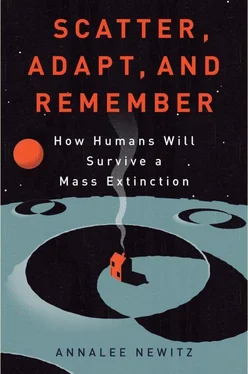Over the coming centuries, we’ll need to take measures more drastic than cutting back on fossil-fuel use and ramping up the deployment of alternative energies. Eventually we’ll have to “hack the planet,” as they say in science-fiction movies. And we’ll do that in part by re-creating great planetary disasters from history.
To make Earth more human-friendly, our geoengineering projects will need to cool the planet down and remove carbon dioxide from the atmosphere. These projects fall into two categories. The first, called solar management, would reduce the sunlight that warms the planet. The second, called carbon-dioxide removal, does exactly what it sounds like. Futurist Jamais Cascio, author of Hacking the Earth: Understanding the Consequences of Geoengineering, predicts that we’ll see an attempt to initiate a major geoengineering project in the next 10 years, and it will probably be solar management. “It’s a faster effect and tends to be relatively cheap, and some estimates are in the billion-dollar range,” he said. “It’s cheap enough that a small country or a rich guy with a hero complex who wants to save the world could do it.” Indeed, one solar-management project is already under way, albeit inadvertently. Evidence suggests that sulfur-laced aerosol exhaust emitted by cargo ships on the ocean changes the structure of high clouds, making them more reflective and possibly cooling temperatures over the water. Some solar-management plans take note of this discovery, and propose that we fill the oceans with ships spraying aerosols high into the air. But other strategies are more radical.
To find out how we’d shield our planet from sunlight, I visited the University of Oxford, winding my way through the city’s maze of pale gold spires and stone alleys to find an enclave of would-be geoengineers. Few deliberate geoengineering projects have been tried to date, but the mandate of the future-focused Oxford Martin School is to tackle scientific problems that will become important over the next century. The center is helping invent a field of science that doesn’t properly exist yet—but that will soon become critically important. One of its researchers is Simon Driscoll, a young geophysicist who divides his time between studying historic volcanic eruptions and figuring out how geoengineers could duplicate the effects of a volcano in the Earth’s atmosphere without actually blowing anything up.
Driscoll told me what volcanoes do to the atmosphere while cobbling together cups of tea in the cluttered atmospheric-physics department kitchen. Along with all the flaming lava, they emit tiny airborne particles called aerosols, which are trapped by the Earth’s atmosphere. He cupped his hands into a half sphere over the steam erupting from our mugs of tea, pantomiming the layers of Earth’s atmosphere trapping aerosols. Soot, sulfuric acid mixed with water, and other particles erupt from the volcano, shoot far above the breathable part of our atmosphere but remain hanging somewhere above the clouds, scattering solar radiation back into space. With less sunlight hitting the Earth’s surface, the climate cools. This is exactly what happened after the famous eruption of Krakatoa in the late 19th century. The eruption was so enormous that it sent sulfur-laced particles high into the stratosphere, a layer of atmosphere that sits between ten and forty-eight kilometers above the planet, where they reflected enough sunlight to lower global temperatures by 2.2 degrees Fahrenheit on average. The particles altered weather patterns for several years.
Driscoll drew a model of the upper atmosphere on a whiteboard. “Here’s the troposphere,” he said, drawing an arc. Above that he drew another arc for the tropopause, which sits between the troposphere and the next arc, the stratosphere. Most planes fly roughly in the upper troposphere, occasionally entering the stratosphere. To cool the planet, Driscoll explained, we’d want to inject reflective particles into the stratosphere, because it’s too high for rain to wash them out. These particles might remain floating in the stratosphere for up to two years, reflecting the light and preventing the sun from heating up the lower levels of the atmosphere, where we live. Driscoll’s passion is in creating computer models of how the climate has responded to past eruptions. He then uses those models to predict the outcomes of geoengineering projects.
The Harvard physicist and public-policy professor David Keith has suggested that we could engineer particles into tiny, thin discs with “self-levitating” properties that could help them remain in the stratosphere for over twenty years. “There’s a lot of talk about ‘particle X,’ or the optimal particle,” Driscoll said. “You want something that scatters light without absorbing it.” He added that some scientists have suggested using soot, a common volcanic by-product, because it could be self-levitating. The problem is that data from previous volcanic eruptions shows that soot absorbs low-wavelength light, which causes unexpected atmospheric effects. If past eruptions like Krakatoa are any indication—and they should be—massive soot injections would cool most of the planet, but changes in stratospheric winds would mean that the area over Eurasia’s valuable farmlands would get hotter. So the unintended consequences could actually make food security much worse.
It’s not clear how we’d accomplish the monumental task of injecting the particles, but Driscoll’s colleagues at Oxford believe we could release them from spigots attached to enormous weather balloons. Weather balloons typically fly in the stratosphere, and they could release reflective particles as a kind of cloud while remaining tethered to an ocean vessel. The stratosphere’s intense winds would carry the particles all around the globe. However, getting particles into the atmosphere isn’t the tough part.
The real issues, for Driscoll and his colleagues, are the unintended consequences of doping our atmosphere with substances normally unleashed during horrific catastrophes. Rutgers atmospheric scientist Alan Robock has run a number of computer simulations of the sulfate-particle injection process, and warns that it could destroy familiar weather patterns, erode the ozone layer, and hasten the process of ocean acidification, a major cause of extinctions.
“I think a lot about the doomsday things that might happen,” Driscoll said. Unintended warming and acidification are two possibilities, but geoengineering could also “shut down monsoons,” he speculated. There are limits to what we can predict, however. We’ve never done anything like this before.
If the planet starts heating up rapidly, and droughts are causing mass death, it’s very possible that we’ll become desperate enough to try solar management. The planet would rapidly cool a few degrees, and give crops a chance to thrive again. What will it be like to live through a geoengineering project like that? “People say we’ll have white skies—blue skies will be a thing of the past,” Cascio said. Plus, solar management is only “a tourniquet,” he warned. The greater injury would still need treating. We might cut the heat, but we’d still be coping with elevated levels of carbon in our atmosphere, interacting with sunlight to raise temperatures. When the reflective particles precipitated out of the stratosphere the planet would once again undergo rapid, intense heating. “You could make things significantly worse if you’re not pulling carbon down at the same time,” Cascio said. That’s why we need a way of removing carbon from the atmosphere while we’re blocking the sun.
Turning Earth into a Carbon-Eating Machine
One of the only geoengineering efforts ever tried was aimed at pulling carbon out of the atmosphere using one of the Earth’s most adaptable organisms: algae called diatoms. Researchers have suggested that we could scrub the atmosphere by re-creating the conditions that created our oxygen-rich atmosphere in the first place. In several experiments, geoengineers fertilized patches of the Southern Sea with powdered iron, creating a feast for local algae. This resulted in enormous algae blooms. The scientists’ hope was that the single-celled organisms could pull carbon out of the air as part of their natural life cycle, sequestering the unwanted molecules in their bodies and releasing oxygen in its place. As the algae died, they would fall to the ocean bottom, taking the carbon with them. During many of the experiments, however, the diatoms released carbon back into the atmosphere when they died instead of transporting it into the deep ocean. Still, a few experiments suggested that carbon-saturated algae can sink to the ocean floor under the right conditions. More recently, an entrepreneur conducted a rogue geoengineering project of this type off the coast of Canada. The diatoms bloomed, but the jury is still out on whether ocean fertilization is a viable option.
Читать дальше






![Аннали Ньюиц - Автономность [litres]](/books/424681/annali-nyuic-avtonomnost-litres-thumb.webp)





